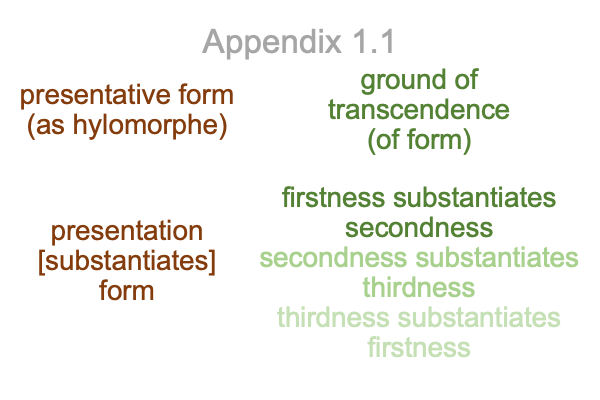0161 What about Appendix 3, titled “Synechism and semiosis”?
0162 Well, I best look into Appendix 4, which presents a helpful list of definitions.
“Synechism” is a principle of continuity. There are no hard and fast distinctions between possibilities, because firstness is monadic. In the empirio-schematic judgment, the dyad, a noumenon [cannot be objectified as] its phenomena, exists in the realm of possibility and obeys this principle. There are no phenomena without their noumenon. There is no noumenon without its phenomena. The hazards of synechism are yet to be deeply appreciated. For scientific inquiry, what happens when certain actors claim to be observing the phenomena of a noumenon which is not… um… obvious to other people?
“Tychism” is a corollary of synechism. Peirce envisions chance (er… possibility) as universal. Without possibility, there is no actuality or normal context. If there is an actuality that appears out of nowhere, in such a fashion that it has no normal context, then we are back to phenomena of a noumenon which is not… um… subject to understanding.
“Semiosis” is the action of signs. Signs are triadic relations. Triadic relations constitute the human niche.
0163 For the Lebenswelt that we evolved in, our ancestors adapt to an ultimate niche as well as many proximate niches. This means that hominin evolution is both convergent, with respect to our ultimate niche, and divergent, with respect to many proximate niches. The ultimate niche is the potential of triadic relations. The proximate niches are regional ecologies and environments.
Language evolves in the milieu of hand talk. Hand talk relies on the semiotic qualities of icons and indexes to motivate a relation between parole (hand talk) and langue (mental processing). As this motivated relation becomes more and more conventional (that is, habitual within hominin social circles), hand-talk gestures become more and more like signs in an arbitrary system of differences (that is, symbols). Grammar consists of symbolic operations within a finite set of symbols. By the time anatomically modern humans appear, hand talk is fully linguistic.
0164 Speech is added to hand talk with the appearance of our own species, Homo sapiens.
Humans practice hand-speech talk for around 200,000 years, with great success.
0165 Around 7,800 years ago, the end of the previous ice age raises sea-levels, flooding shallow geological basins such as what is now the Persian Gulf. In the process, two hand-speech talking cultures, one settled on the basin and one settled along the coast and river gorge, are forced into proximity. A pidgin and then a creole ensues. The creole is the Sumerian language (unrelated to the nearby Semitic languages). But, more importantly, this creole is the first instance of speech-alone talk.
At its inception, the Ubaid of southern Mesopotamia is the only culture in the world practicing speech-alone talk.
It is no coincidence that the world’s earliest civilization arises in southern Mesopotamia.
Speech-alone talk potentiates civilization.
0166 Our current Lebenswelt is marked by speech-alone talk. Speech-alone talk spreads from the Ubaid to the four-corners of the world, potentiating unconstrained social complexity wherever it goes.
7800 years ago, the world population may have been as many as seven million.
Today, it is seven billion.
Such is the significance of the first singularity, the transition from hand-speech talk to speech-alone talk.
0167 Heidegger is a German philosopher who strives to restart Western philosophy after it fumbles its founding charisma.
Peirce is a precocious American post-modern who becomes fascinated with one of the crucial questions asked by scholastic philosophers, “What is the causality inherent to the sign-relation?”
0168 Both these philosophers propose ideas that address a single question, “What is the nature of our current Lebenswelt?”
Their answers apply to a single actuality.
0169 I do not know the name of this actuality, but I do appreciate the significance of Kemple’s attempt to delineate an intersection (without being aware that the term, “intersection”, might have a technical definition that supports his inquiry).
An intersection is an actuality composed of two actualities, each of which has its own nested form.
0170 For these reasons, Brian Kemple’s book, The Intersection of Semiotics and Phenomenology: Peirce and Heidegger in Dialogue, deserves interest. While my examinations, so far, covering the term, “intersection”, and the appendices, are sparse, they are suggestive. There is a lot at play within the pages of this book.



















